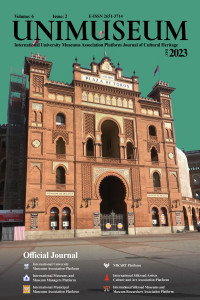Abstract
Hegra is an ancient desert region in Saudi Arabia that has now been transformed into a tourist destination. Many explorers have visited this area, but the first person to set foot in this abandoned city after years was the British explorer Charles Montagu Doughty. The history of this region dates back to the Nabatean era. The people were farmers and livestock breeders who became wealthy through the construction of caravanserais and trade, especially in spices and incense. They chose Hegra as their second capital after Petra to control the trade routes. The Nabatean language is a combination of ancient Arabic and Semitic. Some consider this city cursed due to the inscriptions and curses written on the tombs, although in addition to the tombs, there are also places for worship and water wells, demonstrating the people's ability to store water. Their expertise in water conservation and unparalleled construction evident as they carved homes and water wells out of stones. The remaining artifacts are a complete testament to their capabilities. The existing evidence suggests the integration of this city into the Roman Empire.
Keywords
References
- 1. Azarnush, Azartaş. (1972). Look at the history of Thamud tribe, 31-59
- 2. Emadzadeh, Hossein. (2009). From Adam to Khatam. Islam publications
- 3. Ruhangiz, Lale. (2004). Examining the archeological records of Madain Saleh, Binat, number 51, 166-180
- 4. Tabatabai, Seyyed Mohammad Hossein. (2010). Tafsir al-Mizan, 10 volume, Second edition, Tehran, Dar alKatb alIslamiya publications.
- Internet Resources:
- 1. Jona Lendering, Hegra, https://www.livius.org/articles/ place/dedan/hegra/, Date of access:16.12.2021
- 2. Jonathan Gornall, Rebecca Anne Proctor, The rebirth of AlUla. https://www.arabnews.com/Alula, Date of access:16.12.2021
- 3. Lauren Keith, Hegra, an Ancient City in Saudi Arabia Untouched for Millennia, Makes Its Public Debut, Smithsonianmag Travel, November 23, 2020. https://www.smithsonianmag.com/travel/hegra-ancient- city-saudi-arabia-untouched-for-millenniamakes- its-public-debut-180976361/, Date of access: 15.12.2021
- 4. Paolo, Cimadomo. (2019). The controversial annexation of the Nabataean Kingdom, Levant
- 5.https://www.researchgate.net/publication/333826980 Date of access:17.12.2023
- 6. Woodfield, Margery. (2019). Madain Saleh; A “silent and cursed” city in the deserts of Arabia.
- 7.https://www.bbc.com/persian/magazine-47893723, Date of access:14.12.2021
- 8. Unesco, Hegra Archaeological Site (al-Hijr / Madā ͐ in Ṣāliḥ). https://whc.unesco.org/en/list/1293/, Date of access:17.12.2021
- 9. Linder, Manfred. (1973). An archaeological expedition to Jordan (1973).
- 10.chrome-extension://efaidnbmnnnibpcajpcglclefindmkaj/ https://www.zobodat.at/pdf/Naturund- Mensch_2002_0067-0070.pdf, Date of access: 17.12.2021
- 11. Charloux, Guillaume. Bouchaud, Charlene. Durand, Caroline. Gerber, Yvonne. Studer, Jacqueline. (2018). Living in madain salih hegra during the late pre-islamic period.The excavation of area 1 in the ancient city, Seminar for Arabian Studies Vol. 48, Papers from the fifty-first meeting of the Seminar for Arabian Studies held at the British Museum, London, 4th to 6th August 2017 (2018), pp. 47-65. Archaeopress publications. https://www.jstor.org/stable/45163144, Date of access:17.12.2021
- 12. The Mysterious Nabateans, http://www.kinghussein. gov.jo/his_nabateans.html, Date of access: 17.12.2023 13. Wikipedia. https://en.wikipedia.org/wiki/Nabataeans, Date of access:17.12.2023
Abstract
References
- 1. Azarnush, Azartaş. (1972). Look at the history of Thamud tribe, 31-59
- 2. Emadzadeh, Hossein. (2009). From Adam to Khatam. Islam publications
- 3. Ruhangiz, Lale. (2004). Examining the archeological records of Madain Saleh, Binat, number 51, 166-180
- 4. Tabatabai, Seyyed Mohammad Hossein. (2010). Tafsir al-Mizan, 10 volume, Second edition, Tehran, Dar alKatb alIslamiya publications.
- Internet Resources:
- 1. Jona Lendering, Hegra, https://www.livius.org/articles/ place/dedan/hegra/, Date of access:16.12.2021
- 2. Jonathan Gornall, Rebecca Anne Proctor, The rebirth of AlUla. https://www.arabnews.com/Alula, Date of access:16.12.2021
- 3. Lauren Keith, Hegra, an Ancient City in Saudi Arabia Untouched for Millennia, Makes Its Public Debut, Smithsonianmag Travel, November 23, 2020. https://www.smithsonianmag.com/travel/hegra-ancient- city-saudi-arabia-untouched-for-millenniamakes- its-public-debut-180976361/, Date of access: 15.12.2021
- 4. Paolo, Cimadomo. (2019). The controversial annexation of the Nabataean Kingdom, Levant
- 5.https://www.researchgate.net/publication/333826980 Date of access:17.12.2023
- 6. Woodfield, Margery. (2019). Madain Saleh; A “silent and cursed” city in the deserts of Arabia.
- 7.https://www.bbc.com/persian/magazine-47893723, Date of access:14.12.2021
- 8. Unesco, Hegra Archaeological Site (al-Hijr / Madā ͐ in Ṣāliḥ). https://whc.unesco.org/en/list/1293/, Date of access:17.12.2021
- 9. Linder, Manfred. (1973). An archaeological expedition to Jordan (1973).
- 10.chrome-extension://efaidnbmnnnibpcajpcglclefindmkaj/ https://www.zobodat.at/pdf/Naturund- Mensch_2002_0067-0070.pdf, Date of access: 17.12.2021
- 11. Charloux, Guillaume. Bouchaud, Charlene. Durand, Caroline. Gerber, Yvonne. Studer, Jacqueline. (2018). Living in madain salih hegra during the late pre-islamic period.The excavation of area 1 in the ancient city, Seminar for Arabian Studies Vol. 48, Papers from the fifty-first meeting of the Seminar for Arabian Studies held at the British Museum, London, 4th to 6th August 2017 (2018), pp. 47-65. Archaeopress publications. https://www.jstor.org/stable/45163144, Date of access:17.12.2021
- 12. The Mysterious Nabateans, http://www.kinghussein. gov.jo/his_nabateans.html, Date of access: 17.12.2023 13. Wikipedia. https://en.wikipedia.org/wiki/Nabataeans, Date of access:17.12.2023
Details
| Primary Language | English |
|---|---|
| Subjects | Architectural History, Theory and Criticism |
| Journal Section | Articles |
| Authors | |
| Early Pub Date | December 29, 2023 |
| Publication Date | December 29, 2023 |
| Submission Date | December 12, 2023 |
| Acceptance Date | December 27, 2023 |
| Published in Issue | Year 2023 Volume: 6 Issue: 2 |
CreativeCommons Attribtion-ShareAlike 4.0 International Licence 146271331027042
Diamond Open Access refers to a scholarly publication model in which journals and platforms do not charge fees to either authors or readers.
Open Access Statement:
This is an open access journal which means that all content is freely available without charge to the user or his/her institution. Users are allowed to read, download, copy, distribute, print, search, or link to the full texts of the articles, or use them for any other lawful purpose, without asking prior permission from the publisher or the author. This is in accordance with the BOAI definition of open access.
Archiving Policy:
http://jfhs.scientificwebjournals.com/en/pub/jfhs/lockss-manifest
Archiving is done according to ULAKBİM "DergiPark" publication policy (LOCKSS).

